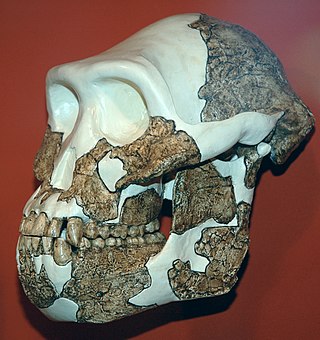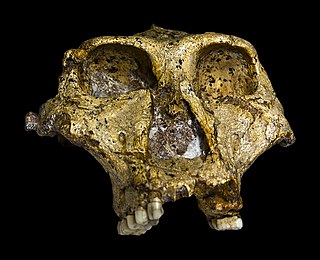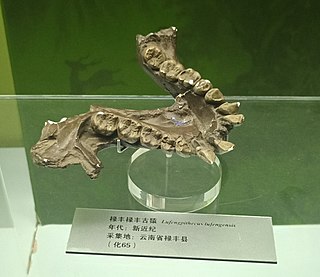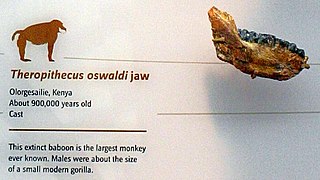
Paranthropus is a genus of extinct hominin which contains two widely accepted species: P. robustus and P. boisei. However, the validity of Paranthropus is contested, and it is sometimes considered to be synonymous with Australopithecus. They are also referred to as the robust australopithecines. They lived between approximately 2.6 and 1.2 million years ago (mya) from the end of the Pliocene to the Middle Pleistocene.

Smilodon is a genus of the extinct machairodont subfamily of the felids. It is one of the most famous prehistoric mammals and the best known saber-toothed cat. Although commonly known as the saber-toothed tiger, it was not closely related to the tiger or other modern cats. Smilodon lived in the Americas during the Pleistocene epoch. The genus was named in 1842 based on fossils from Brazil; the generic name means "scalpel" or "two-edged knife" combined with "tooth". Three species are recognized today: S. gracilis, S. fatalis, and S. populator. The two latter species were probably descended from S. gracilis, which itself probably evolved from Megantereon. The hundreds of individuals obtained from the La Brea Tar Pits in Los Angeles constitute the largest collection of Smilodon fossils.

Homo rudolfensis is an extinct species of archaic human from the Early Pleistocene of East Africa about 2 million years ago (mya). Because H. rudolfensis coexisted with several other hominins, it is debated what specimens can be confidently assigned to this species beyond the lectotype skull KNM-ER 1470 and other partial skull aspects. No bodily remains are definitively assigned to H. rudolfensis. Consequently, both its generic classification and validity are debated without any wide consensus, with some recommending the species to actually belong to the genus Australopithecus as A. rudolfensis or Kenyanthropus as K. rudolfensis, or that it is synonymous with the contemporaneous and anatomically similar H. habilis.

Gigantopithecus is an extinct genus of ape from roughly 2 million to 350,000 years ago during the Early to Middle Pleistocene of southern China, represented by one species, Gigantopithecus blacki. Potential identifications have also been made in Thailand, Vietnam, and Indonesia. The first remains of Gigantopithecus, two third molar teeth, were identified in a drugstore by anthropologist Ralph von Koenigswald in 1935, who subsequently described the ape. In 1956, the first mandible and more than 1,000 teeth were found in Liucheng, and numerous more remains have since been found in at least 16 sites. Only teeth and four mandibles are known currently, and other skeletal elements were likely consumed by porcupines before they could fossilise. Gigantopithecus was once argued to be a hominin, a member of the human line, but it is now thought to be closely allied with orangutans, classified in the subfamily Ponginae.

Australopithecus africanus is an extinct species of australopithecine which lived between about 3.3 and 2.1 million years ago in the Late Pliocene to Early Pleistocene of South Africa. The species has been recovered from Taung, Sterkfontein, Makapansgat, and Gladysvale. The first specimen, the Taung child, was described by anatomist Raymond Dart in 1924, and was the first early hominin found. However, its closer relations to humans than to other apes would not become widely accepted until the middle of the century because most had believed humans evolved outside of Africa. It is unclear how A. africanus relates to other hominins, being variously placed as ancestral to Homo and Paranthropus, to just Paranthropus, or to just P. robustus. The specimen "Little Foot" is the most completely preserved early hominin, with 90% of the skeleton intact, and the oldest South African australopith. However, it is controversially suggested that it and similar specimens be split off into "A. prometheus".

Australopithecus anamensis is a hominin species that lived approximately between 4.2 and 3.8 million years ago and is the oldest known Australopithecus species, living during the Plio-Pleistocene era.

Paranthropus robustus is a species of robust australopithecine from the Early and possibly Middle Pleistocene of the Cradle of Humankind, South Africa, about 2.27 to 0.87 million years ago. It has been identified in Kromdraai, Swartkrans, Sterkfontein, Gondolin, Cooper's, and Drimolen Caves. Discovered in 1938, it was among the first early hominins described, and became the type species for the genus Paranthropus. However, it has been argued by some that Paranthropus is an invalid grouping and synonymous with Australopithecus, so the species is also often classified as Australopithecus robustus.

Victoriapithecus macinnesi was a primate from the middle Miocene that lived approximately 15 to 17 million years ago in Northern and Eastern Africa. Through extensive field work on Maboko Island in Lake Victoria, Kenya, over 3,500 specimens have been found, making V. macinnesi one of the best-known fossil primates. It was previously thought that perhaps multiple species of Victoriapithecus were found, however the majority of fossils found indicate there is only one species, V. macinnesi. Victoriapithecus shows similarities to the extant subfamilies Colobinae and Cercopithecinae. However, Victoriapithecus predates the last common ancestor of these two groups and instead is thought to be a sister taxon.

Feliformia is a suborder within the order Carnivora consisting of "cat-like" carnivorans, including cats, hyenas, mongooses, viverrids, and related taxa. Feliformia stands in contrast to the other suborder of Carnivora, Caniformia.

Post-canine megadontia is a relative enlargement of the molars and premolars compared to the size of the incisors and canines. This phenomenon is seen in some early hominid ancestors such as Paranthropus aethiopicus.

Lufengpithecus is an extinct genus of ape in the subfamily Ponginae. It is known from thousands of dental remains and a few skulls and probably weighed about 50 kg (110 lb). It contains three species: L. lufengensis, L. hudienensis and L. keiyuanensis. Lufengpithecus lufengensis is from the Late Miocene found in China, named after the Lufeng site and dated around 6.2 Ma. It is the latest Miocene fossil ape that has been discovered in the entire world. Some researchers believe that genus Lufengpithecus could be an ancestor to African apes and hominids.

Sexual dimorphism describes the morphological, physiological, and behavioral differences between males and females of the same species. Most primates are sexually dimorphic for different biological characteristics, such as body size, canine tooth size, craniofacial structure, skeletal dimensions, pelage color and markings, and vocalization. However, such sex differences are primarily limited to the anthropoid primates; most of the strepsirrhine primates and tarsiers are monomorphic.
Gorgopithecus is an extinct genus of primate, in the old word monkey family Cercopithecidae, closely related to the baboons. There is only one known species, Gorgopithecus major. It has been found at sites from the Pliocene and Early Pleistocene Epoch in South Africa and Tanzania. It was first discovered at the Kromdraai A site in South Africa. It has since been found from Swartkrans, South Africa. Most recently, it has been recognized from the DKI site in Bed I of Olduvai Gorge, Tanzania, which has been dated to 1.8 million years old.

Dinopithecus is an extinct genus of very large primate closely related to the baboon that lived during the Pliocene to the Pleistocene epoch of South Africa and Ethiopia. It was named by British paleontologist Robert Broom in 1937. The only species currently recognized is Dinopithecus ingens, as D. quadratirostris has been reassigned to the genus Soromandrillus. It is known from several infilled cave sites in South Africa, all of early Pleistocene age, including Skurweberg, Swartkrans, and Sterkfontein.

Graecopithecus is an extinct species of hominid that lived in southeast Europe during the late Miocene around 7.2 million years ago. Originally identified by a single lower jaw bone bearing a molar tooth found in Pyrgos Vasilissis, Athens, Greece, in 1944, other tooth specimens were discovered from Azmaka quarry in Bulgaria in 2012. With only little and badly preserved materials to reveal its nature, it is considered as "the most poorly known European Miocene hominoids." The creature was popularly nicknamed 'El Graeco' by scientists.
Plesiopithecus is an extinct genus of early strepsirrhine primate from the late Eocene.

Theropithecus oswaldi is an extinct species of Theropithecus from the early to middle Pleistocene of Kenya, Ethiopia, Tanzania, South Africa, Spain, Morocco and Algeria. It appears to have been a specialised grazer. The species went extinct in South Africa around 1.0 Ma. Having existed alongside hominins like Homo erectus, it is likely that conflict with early humans played a role in their extinction as a site has been found with many juveniles butchered.
Changes to the dental morphology and jaw are major elements of hominid evolution. These changes were driven by the types and processing of food eaten. The evolution of the jaw is thought to have facilitated encephalization, speech, and the formation of the uniquely human chin.
Pliopapio is an extinct genus of Old World monkey known from the latest part of the Miocene to the early Pliocene Epochs from the Afar Region of Ethiopia. It was first described based on a very large series of fossils from the site of Aramis in the Middle Awash, which has been dated by 40Ar/39Ar to 4.4 million years old. It has since been found from similarly aged sediments at Gona, approximately 75 km to the North. Additional fossils from the Middle Awash extend its known time range back to at least 5.3 million years ago. There is only one known species, Pliopapio alemui.
Bolt's Farm is a palaeontological site in the Cradle of Humankind World Heritage Site, Gauteng province, South Africa. With more than 30 fossil deposits dating back 4.5 Ma, it is one of the oldest sites currently discovered in the Cradle of Humankind. It consists of multiple cavities, pits, and quarries, where caves have eroded away, exposing their fossiliferous interiors. Although this site has not yet yielded the hominid fossils for which the Cradle of Humankind is known, Bolt's Farm is still an important source of fossils from various species of Early Pliocene and Plio-Pleistocene fauna, including primates and big cats.


















